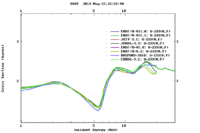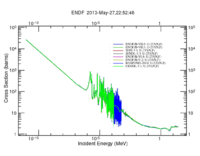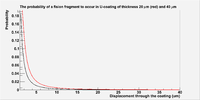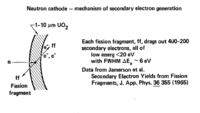Difference between revisions of "Fission fragment trasport out of U-233"
| (6 intermediate revisions by the same user not shown) | |||
| Line 14: | Line 14: | ||
=Probability of a fission fragment to create a signal= | =Probability of a fission fragment to create a signal= | ||
| − | U-233 is relatively sensitive but the coating thickness may stop the fission fragments. Compared to the other neutron sensitive targets, U-233 is relatively sensitive to a wide energy range of neutrons, the range may extend from 0.1 MeV to more than 30 MeV. However, coating thickness determines | + | U-233 is relatively sensitive but the coating thickness may stop the fission fragments. Compared to the other neutron sensitive targets, U-233 is relatively sensitive to a wide energy range of incident neutrons, the range may extend from 0.1 MeV to more than 30 MeV. However, the coating thickness determines if a fission fragment can escape from its surface and to cause an ionization. The range of a fission fragment is calculated in UO3, of thickness 0.1 um and density 7.29 g/cm^3, is 12.07 +_ 0.09 um, <ref name = Hudler> J.C. hadler, Radiation Measurements Vol 43 (2008) pf S334-S336</ref> assuming the fission fragment mobility is the same as the UO3. As the thickness increases more than 0.1 um, the range will decrease according to the following equation <ref name = Hudler/> : |
<math> R= R_T - <r> </math> | <math> R= R_T - <r> </math> | ||
| Line 20: | Line 20: | ||
<math> <r> = \frac{ln(d/R_T) + 0.5}{ 2/d (1-R_T/d) + R_T^{-1}} </math> | <math> <r> = \frac{ln(d/R_T) + 0.5}{ 2/d (1-R_T/d) + R_T^{-1}} </math> | ||
| + | The previuos equation is derived from defining the probability of a fission a fission fragment to occur in a distance r with an angle \theta as the following: | ||
| − | Producing free electrons in the gas will consequently create a signal. Although the fission fragment leaves the surface of U-233 coating and ionizes the gas, but minimum 200 electrons of energy around 20 eV become free through the | + | <math> Probability = \frac{d}{4\pi r^2 R} </math> |
| + | |||
| + | The following figure shows the probability values for 40 um and 20 um coating thickess of U-233, the highest probability for a fission fragment to escape to the gas when the fission event creates it within 1 um from the coating surface. | ||
| + | |||
| + | [[File:ff_esc_prob_hudler_2008.png |200px]] | ||
| + | |||
| + | |||
| + | |||
| + | |||
| + | Producing free electrons in the gas will consequently create a signal. Although the fission fragment leaves the surface of U-233 coating and ionizes the gas, but minimum 200 electrons of energy around 20 eV become free through the fission fragment's track in the U-233 coating of thickness 1-10um. <ref name = Wang> Wang Jin et al, Applied Physics Letters, Vol 82, 20 (2003) pf 3553-3555</ref> , separating the electrons from the higher energy ones that are scattered freely from a fission fragment's ionization is beyond the scope of this research. | ||
| Line 36: | Line 46: | ||
<references/> | <references/> | ||
| + | |||
| + | |||
| + | |||
| + | |||
| + | |||
| + | |||
| + | GO BACK [https://wiki.iac.isu.edu/index.php/Performance_of_THGEM_as_a_Neutron_Detector#Problem_Statement] | ||
Latest revision as of 02:05, 29 August 2013
U-233 Coating
The fission chamber has a fissionable material as a neutron sensitive target. The fission chambers have usually target material that make them sensitive for neutrons that belongs to an energy range, the most commonly used material for detecting thermal neutron is U-235, in case of fast neutron Th-232 and U-238 represent good target. In some cases the fission chamber may contain more than one target to detect a wide range of emitted neutrons.<ref name= "Andriamonje"> Novel Micromegas Detector for In-Core Nuclear Reactor Neutron Flux Measurements </ref>
In this research, the neutron sensitive material used in the fission chamber is Uranium 233(U-233). U-233 has a relatively high neutron fission cross section in the energy range of 0.1-30 MeV as shown in the figure below.
The coating is on a circular metal plate which is in a direct contact to the cathode. The coating of U-233 has a circular shape of an inch in diameter and 20-40 um in thickness. The U-233 circular plate is glued to a square FR4 copper clad plate of length of 12 cm and thickness of 1 mm (cathode), the plate has a hole of 4 cm in diameter that keeps the U-233 coating exposed to the chamber gas.
Probability of a fission fragment to create a signal
U-233 is relatively sensitive but the coating thickness may stop the fission fragments. Compared to the other neutron sensitive targets, U-233 is relatively sensitive to a wide energy range of incident neutrons, the range may extend from 0.1 MeV to more than 30 MeV. However, the coating thickness determines if a fission fragment can escape from its surface and to cause an ionization. The range of a fission fragment is calculated in UO3, of thickness 0.1 um and density 7.29 g/cm^3, is 12.07 +_ 0.09 um, <ref name = Hudler> J.C. hadler, Radiation Measurements Vol 43 (2008) pf S334-S336</ref> assuming the fission fragment mobility is the same as the UO3. As the thickness increases more than 0.1 um, the range will decrease according to the following equation <ref name = Hudler/> :
The previuos equation is derived from defining the probability of a fission a fission fragment to occur in a distance r with an angle \theta as the following:
The following figure shows the probability values for 40 um and 20 um coating thickess of U-233, the highest probability for a fission fragment to escape to the gas when the fission event creates it within 1 um from the coating surface.
Producing free electrons in the gas will consequently create a signal. Although the fission fragment leaves the surface of U-233 coating and ionizes the gas, but minimum 200 electrons of energy around 20 eV become free through the fission fragment's track in the U-233 coating of thickness 1-10um. <ref name = Wang> Wang Jin et al, Applied Physics Letters, Vol 82, 20 (2003) pf 3553-3555</ref> , separating the electrons from the higher energy ones that are scattered freely from a fission fragment's ionization is beyond the scope of this research.
<references/>
GO BACK [1]



